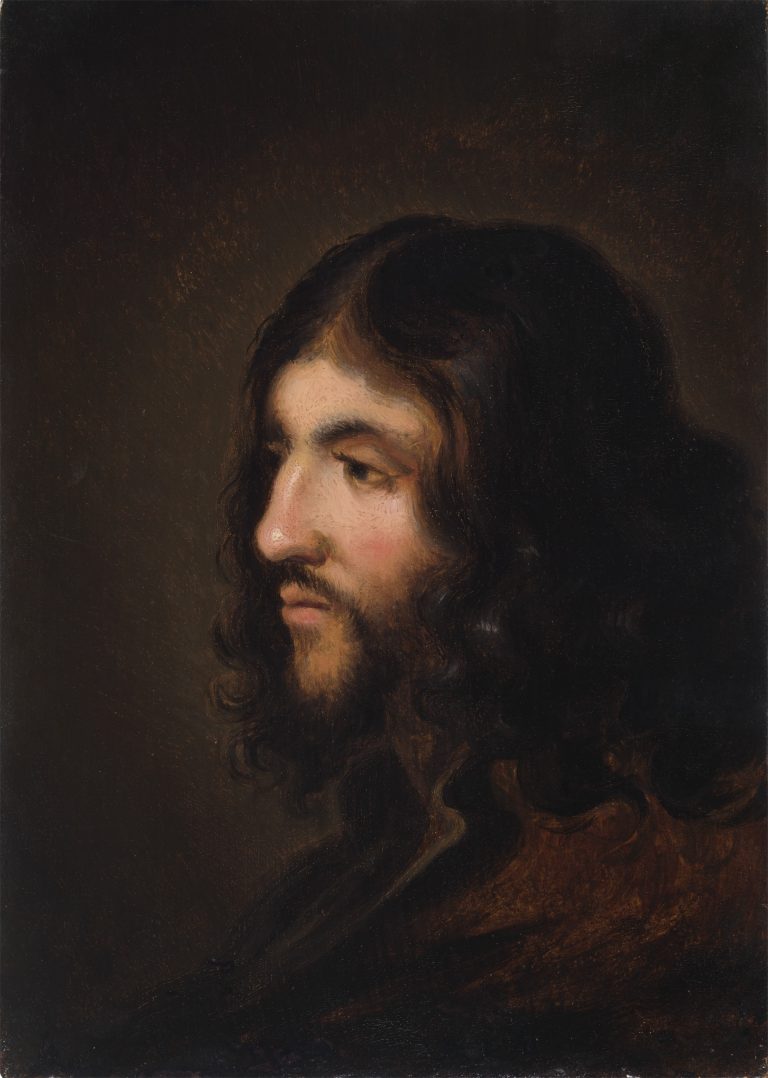This small panel bears the bust of a young bearded man turned to the left, his profile emphatically set off by his shoulder-length curly hair. Only a sliver of the right eyebrow and an indication of the right eyelid are visible, suggesting a slight turn toward the viewer. The torso is ensconced in a brown garment, which blends into the color of the background, and so the viewer’s eye comes to rest on the man’s face, lit from the upper left. The expression of this smooth visage—the closed mouth and the half-closed eyes staring unfocused into the distance—suggests the serious and internalized gaze of the model.
The man’s appearance—in particular the dark brown hair, short beard, and lightly curved eyebrows—points to the description of Jesus appearing in Samuel van Hoogstraten’s treatise on painting, published in 1678:
His hair is of the color of the ripe hazelnut, parted on the top in the manner of the Nazarites, and falling straight down to the ears, but curling further below, with blond highlights and fanning off his shoulders. He has a fair forehead and no wrinkles or marks on his face, his cheeks are tinged with pink . . . his beard is large and full but not long, and parted in the middle. His glance shows simplicity adorned with maturity, his eyes are clear and commanding, never apt to laugh.1
Van Hoogstraten (1627–78) drew his description from the so-called Lentulus Letter, which was then thought to provide a contemporary description of Jesus’s physical appearance.2 Indeed, a group of twelve bust-length oil studies of the head of Jesus painted by Rembrandt van Rijn (1606–69) and his pupils from the late 1640s to the mid-1650s seems to follow the description in this letter. As Lloyd DeWitt has demonstrated, these representations of what was thought to be an eyewitness description formed a radical break with the existing iconographic tradition.3 Instead of following the tradition of icon painting, Rembrandt and his pupils “brought to life” an image of Jesus by portraying him with his head slightly turned or inclined. In these works, the facial expression is “turned inward,” and the figure is rendered in loose, painterly brushwork. That these artists based their images on living models is confirmed by contemporary sources. Rembrandt’s own inventory of 1656 includes, alongside two Christus tronie van Rembrandt (“head of Christ by Rembrandt”), a Christus tronie naar het leven (“ head of Christ from life”) that must be connected to this group of head studies.4 The poet Jan Vos (1612–67), furthermore, indicates that Rembrandt and his pupils used Jewish models in their depictions of Jesus. In writing about a painting by Govaert Flinck (1615–60), the author explains with a sarcastic (and anti-Semitic) tone why Jesus is shown with a closed mouth: “because the model was a Jew.”5
The present painting relates closely to this group of head studies, but it diverges from them in one critical aspect: it is the only one that represents the head of Jesus in profile. One of the few precedents for this pose is a woodcut of 1512 by Hans Burgmaier (fig 1), which accompanied the publication of the Lentulus Letter. Burgmaier’s print depicts a profile image of Jesus in a circle, thereby alluding to portraits of rulers from antiquity and the Renaissance in which the profile pose emphasized the status and character of the sitter.6
According to dendrochronological analysis, the panel for this head study could have been available for painting as early as 1625, which opens the possibility that this work was executed at an earlier date than were the heads of Jesus created in the Rembrandt workshop in the late 1640s.7 Indeed, the handling of the figure relates more closely to the works that Rembrandt and his students created in the 1630s than in the 1640s. The painting’s execution most closely resembles Govaert Flinck’s manner of painting figures when he was working in the workshop of Hendrick Uylenburgh (1584/89–ca. 1660) during the late 1630s. There, under the inspiration of Rembrandt’s powerful effects of chiaroscuro, as well as that master’s muted palette and heightened observation of emotion, Flinck gradually moved away from the aesthetic of his first teacher, Lambert Jacobsz (ca. 1598–1636). Flinck’s The Lamentation, 1637, in Tokyo, demonstrates the smooth modeling and blunt chiaroscuro that marks the young artist’s works from this transitional period of his career (fig 2).8 The pinkish flesh tones, white highlights, and heavy black eyes in the Leiden Collection painting are entirely consistent with the faces in The Lamentation.
As is evident in the Tokyo painting, as well as in his Isaac Blessing Jacob, datable to about 1635 (fig 3), Flinck had a penchant for painting heads in profile.9 With most of these profiles, Flinck used the telling device of a swath of dark hair that falls down the far side of the face, coming forward a bit artificially, and sets off the lighter contour. Flinck may have adapted this way of arranging hair from Rembrandt’s early self-portraits, but he quickly abandoned this approach in his later works as he gained mastery of the human head and its lighting from a variety of angles. Perhaps Flinck had another Passion scene in mind when he made this relatively direct study, which is both powerfully observed from life and rendered in a compelling fashion.10
